In 1922, T.E. Lawrence (Lawrence of Arabia) wrote a memoir of his time in the desert entitled “The Seven Pillars of Wisdom.” In his reflection, he talked of his experience with the tempering of the soul. The word “tempering” is often associated with the process of making something stronger and more resilient. In this article, I’d like to offer what I consider the Three Pillars of “tempering the body for healthy aging.” I came to kettlebell training later in life. I am an exercise physiologist and physician but found kettlebell training during my rehabilitation from surgery for an acute lumbar disc herniation at age 63. I passed my SFG Level I Certification six months before my 65th birthday and SFG Level II Certification at age 67. As I look at factors that define healthy aging, I would argue that the scientific data on what I call “future proofing” against the frailty of aging (the recipe to go strongly into our sixties and beyond) rests upon Three Pillars of tempering: grip, posture, and the ability to get up from the floor. In this article, I will discuss each pillar and the science that supports it. Afterwards, I offer some of my own programming suggestions to “temper the body” using these Three Pillars.
Pillar 1: Grip Strength through the Tactical Pullup
Grip strength is a reliable biomarker of resilience in aging (or frailty in its absence). Multiple studies of one hundred thousand plus participants show that grip strength is a predictor of mortality in a variety of disease states (cancer, heart disease, etc.). And, that a weak grip increases the likelihood of dying in healthy adults older than sixty.1, 2, 3 One of the many wisdoms of kettlebell practice is its central tenant: grip strength. Grip strength is developed by many of the core skills: swings, cleans, snatches, and presses. Although there are many ways to use kettlebell practice to improve grip strength, I have chosen to focus on the tactical pullup, in which the hollow body position is maintained throughout the entire movement. It is a bodyweight movement and constantly informs the practitioner of the importance of minimizing excess body weight. Moreover, to my mind, it is the best exercise to improve trunk strength, especially the abdominal muscles. The tactical pullup is performed by addressing the bar and contracting the glutes, quads, and abdominal muscles to hollow the midsection. Then, engaging the lats to lift the chest to the bar. Elbows should pull back towards the ground. This is a powerful movement that requires complete removal of slack from the midsection and a tremendous builder of grip strength.
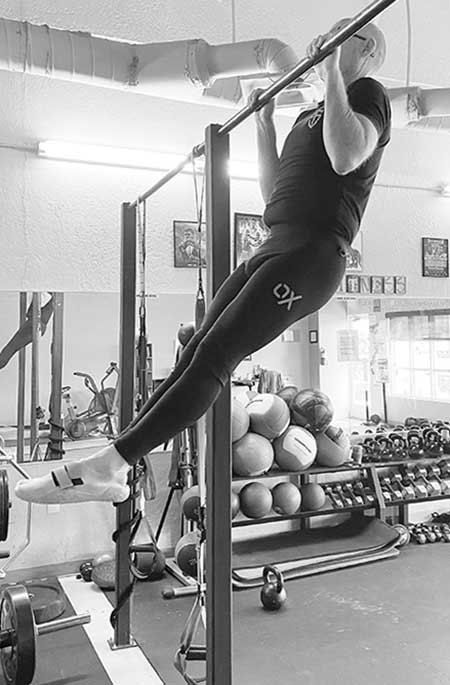
Pillar 2: Posture through the Windmill and Bent Press
Posture is an underappreciated marker of decline and frailty in aging. However, a study from 2015 shows that posture is a better marker of decline than gait speed, which has been the time honored and so-called “gold standard” of healthy aging.4 Numerous training modalities to improve posture have been studied, largely focusing on balance training. As practitioners of strength, we recognize the importance of strength as a key modality. And so, as an exercise physiologist examining the skills practiced in StrongFirst Instructor Certifications, I found that posture can be directly improved through the practice of the windmill and the bent press. A number of discussions on these skills can be found in the StrongFirst literature. However, I will summarize these by saying that the windmill is a stability and mobility skill that focuses on a differentially weighted single-leg pillar. The bent press is a mobility, flexibility, and strength skill built on a pyramid. They seem superficially similar but are very different ways to activate trunk strength and mobility.
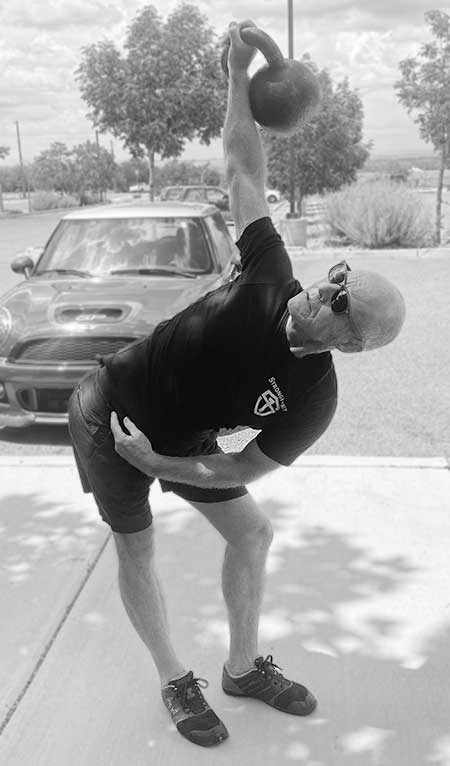
The other benefit of these complimentary skills is that they train thoracic mobility, which ensures that the twisting movements of everyday life are not focused on the lumbosacral spine, but distributed across a much larger area of lumbar, sacral, and thoracic spine. A skilled practitioner of the windmill and the bent press will mimic a water strider insect, who walks on water by displacing weight over a larger area.
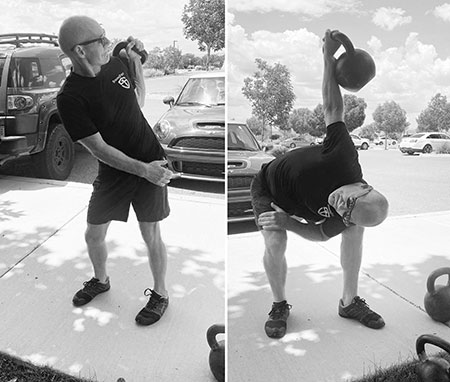
Pillar 3: Getting Up from the Floor through the Get-up
When visiting a science museum, you may see Foucault’s Pendulum knocking over pins as the earth turns beneath the swinging weight. According to the laws of physics, the decoupling of the weight allows the earth to turn beneath it. This is the earth’s get-up. When we do a get-up, we “decouple” the kettlebell from our body, and, like the earth, the body moves below it. Executing a get-up correctly requires a balance of fluidity and strength, hinge, rotation of the body around the fixed overhead weight, and power to drive the weight upward through its imaginary cylinder.
The importance of rising from the floor as a predictor of mortality is probably the best studied of my Three Pillars. In a population of fifty-one- to eighty-year-olds, the ability to rise from a seated position on the floor conferred a 21% survival advantage over a 6.3-year follow-up. Had this been a drug, getting off the floor would have been hailed as a miracle of medicine in the fight against the effects of aging.5
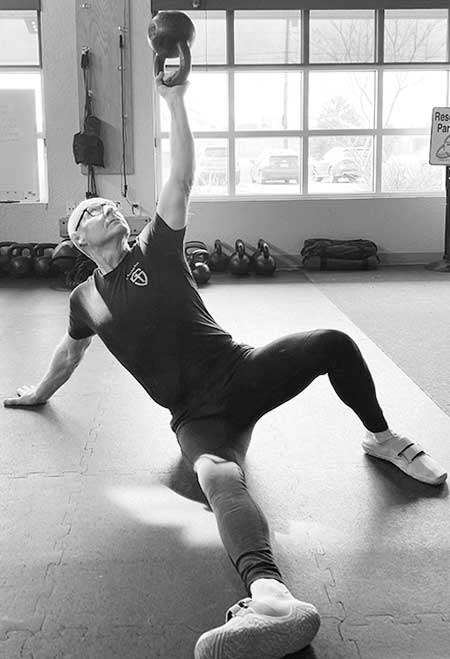
The Three Pillars Program
The Recharge
The recharge is not a training session, but rather a minimal way to activate the strengtheners mentioned in the Three Pillars. Four to six days a week, perform an hourly recharge made up of 30-50% of your maximum pullup reps plus one get-up each side. For the pullups, focus on the perfect tactical pullup: posterior pelvic tilt, toes pointed forward, fully activated glutes, quads, and abdominal muscles prior to pulling through the lats. From a full extension at the bottom, pull the bar to the chest rather than pulling the chin to the bar. Follow the pullups by performing one get-up each side. I suggest using a weight that is one to two sizes bigger than your test weight. You can also drop down one or two kettlebell sizes and do bottoms-up get-ups. Bottoms-up get-ups ensure intentionality and emphasis on the movement. Whichever style get-up you choose, it should focus on form and flow supporting the purpose of the Three Pillars. Perform these movements once an hour for six to nine hours throughout the day. Doing both movements takes three to four minutes, so rest time should be 56-58 minutes. The goal is to be fresh with each rep.
The Grind
This is a six to ten cycle repeat training session that should be performed one to two times a week. Each cycle is composed of a bent press component, a windmill/get-up component, and a pullup component.
Here is one cycle:
- Clean a kettlebell and perform one bent press each side for two to three sets. I suggest using your test weight kettlebell, or if you are advanced in this skill, perhaps one to two sizes larger. Nothing builds pressing power like this apex predator.
- Perform one get-up to standing and complete three windmills in this position. Swing to switch hands, snatch the kettlebell overhead, and do three windmills on the other side, then complete the get-up back to the floor. You can alternate between sides each cycle. For example, beginning on your left side on the odd-number cycles and on your right during even-number cycles.
- Finish the cycle with three perfect tactical pullups.
This 1+2+3 cycle is repeated six to ten times.
Lastly, remember to take your kettlebell for a walk (see the article “Take Your Kettlebell for a Walk” by Abbey Gottinger). At least once a week, choose a kettlebell that is roughly 20-30% of your bodyweight and carry it one mile at a steady aerobic pace. The kettlebell carry increases grip strength, re-enforces correct posture, and provides surprisingly effective endurance training.
Conclusion
As a physician, exercise scientist, and student of strength, I have experienced how kettlebell and bodyweight training build strength and mobility. They teach one how to remove slack from the system developing trunk strength and stability. The combination of these qualities is what “tempers the body” and develops resilience. This resilience becomes even more essential as we age. Science points to the importance of the Three Pillars: grip strength, posture, and getting off the floor. We can improve each pillar with quite a limited set of exercises that build strength and give the body a pattern for healthy movement. How we age is up to us. We have the tools to “future proof” ourselves against the frailty of aging. And what we must do is simple—although not easy. Let’s choose to “temper the body” and go strongly into our sixties and beyond.
References
1 Bohannon RW. Grip Strength: An Indispensable Biomarker For Older Adults Clin Interv Aging. 2019; 14: \ doi: 10.2147/CIA.S194543.
2 Rijk JM, Roos PRKM, Deckx L, van Den Akker M, Buntinx F. Prognostic value of handgrip strength in people aged 60 years and older: a systematic review and meta-analysis. Geriatr Gerontol Int. 2016;16(. doi: 10.1111/ggi.12508.
3 Leong DP et al. Prognostic value of grip strength: findings from the Prospective Urban Rural Epidemiology (PURE) study. The Lancet 368, 2015.
4 RA Merchant et al. Is Trunk Posture in Walking a Better Marker than Gait Speed in Predicting Decline in Function and Subsequent Frailty? JAMDA 17 (1), 2015.
5 de Brito LBB, et al. Ability to sit and rise from the floor as a predictor of all-cause mortality. European Journal of Preventive Cardiology. 2014;21. doi:10.1177/2047487312471759.
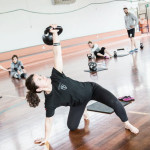
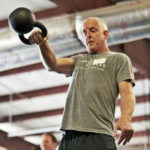
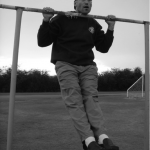



What an interesting article. Thank you.
Great article. One of the main reasons I picked up the kettlebell was to ‘age well’. I did not define what ‘well’ meant, but you’ve articulated that perfectly in the article. Definitely inspired by what you can do at your age and makes me wonder what would I be able to achieve at that age.
Hi Pope and thank you for your article which you clearly put a lot of time and thought into. As a 73 yo orthopedic surgeon who got my SFG 1 cert last April and am getting instruction in level 2 skills for next year’s Chicago cert, I feel a certain kinship. I too was pretty late in finally waking up to the fact that I needed to balance my exercise routine with a strength component. I am ever so grateful for discovering SF as both a teaching paradigm and as an informative and supportive community. Your article and many like it speak to SFs’ goals of education and fellowship.
The windmill and bent press BTW are kicking my butt. But in a good way😅.
Thank you and best of luck with the SFG II Cert. As you can tell from the article, I think that mastering the bent press is a fundamentally important strength skill. It was an essential factor to achieve my SFG II Cert big press. Understanding that the bent press is built on a pyramid, unlike the weighted single leg pillar of the windmill, was a key mental image in my skill acquisition-an image provided by my coach, Zar Horton.
Thank you for sharing. This is similar to one of my programs.
5 Pull ups
1 Turkish get up L/R
5 Pull ups
2 cleans, 1 press, 3 rack squats L/R
Repeat for time, short rest as needed. I usually go for 30
minutes.
Give it a try.
Thank you for the suggestion. That looks like a fair challenge for a training scheme.
I focus on the windmill and bent press for posture and strength. They open the world of thoracic mobility while building core. Both were critical for my SFG II heavy press.
The other thing I’d say reflects my younger days in exercise science where I had the opportunity to work with some of the people who brought interval training to the States. Their message was always that growth and adaptation occur during the rest phase: so for long sets, I insure good rest intervals between work intervals to let the magic happen.
Thanks again for reading and for your comments. I’ll explore your suggestions.
Beautiful article by my brother in strength
Excellent article, thank you for sharing wisdom!
Terrific article, sir, thank you! Health & Strength!
Brilliant article. Thank you Dr Moseley. I’m currently 54, and my wife is 61. I have been a student of Pavel since 1999, and it’s no exaggeration to say that our lives have been saved by what I’ve learnt over those years from Pavel and associates. The guys in my family tend to age quickly and die early. I’m confident I will buck that trend, and I’m in better condition now than I was 30 years ago, by orders of magnitude. My wife has recovered from multiple brain surgeries and the resulting lifelong complications using kettlebells and everything else I’ve learnt. We are yet more proof that SF principles work. I really need to get my SF certs already!